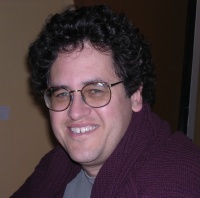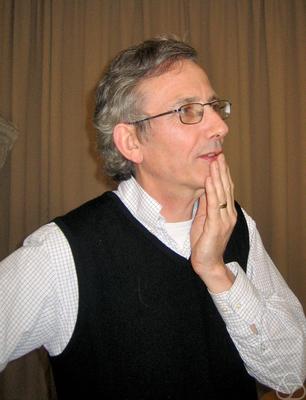Related Research Articles

Differential geometry is a mathematical discipline that studies the geometry of smooth shapes and smooth spaces, otherwise known as smooth manifolds. It uses the techniques of differential calculus, integral calculus, linear algebra and multilinear algebra. The field has its origins in the study of spherical geometry as far back as antiquity. It also relates to astronomy, the geodesy of the Earth, and later the study of hyperbolic geometry by Lobachevsky. The simplest examples of smooth spaces are the plane and space curves and surfaces in the three-dimensional Euclidean space, and the study of these shapes formed the basis for development of modern differential geometry during the 18th and 19th centuries.

John Carlos Baez is an American mathematical physicist and a professor of mathematics at the University of California, Riverside (UCR) in Riverside, California. He has worked on spin foams in loop quantum gravity, applications of higher categories to physics, and applied category theory. Additionally, Baez is known on the World Wide Web as the author of the crackpot index.
In theoretical physics, twistor theory was proposed by Roger Penrose in 1967 as a possible path to quantum gravity and has evolved into a widely studied branch of theoretical and mathematical physics. Penrose's idea was that twistor space should be the basic arena for physics from which space-time itself should emerge. It has led to powerful mathematical tools that have applications to differential and integral geometry, nonlinear differential equations and representation theory, and in physics to general relativity, quantum field theory, and the theory of scattering amplitudes.

Sir Simon Kirwan Donaldson is an English mathematician known for his work on the topology of smooth (differentiable) four-dimensional manifolds, Donaldson–Thomas theory, and his contributions to Kähler geometry. He is currently a permanent member of the Simons Center for Geometry and Physics at Stony Brook University in New York, and a Professor in Pure Mathematics at Imperial College London.
In mathematical physics, constructive quantum field theory is the field devoted to showing that quantum field theory can be defined in terms of precise mathematical structures. This demonstration requires new mathematics, in a sense analogous to classical real analysis, putting calculus on a mathematically rigorous foundation. Weak, strong, and electromagnetic forces of nature are believed to have their natural description in terms of quantum fields.
In mathematics, a bundle gerbe is a geometrical model of certain 1-gerbes with connection, or equivalently of a 2-class in Deligne cohomology.
In theoretical physics, the Penrose transform, introduced by Roger Penrose, is a complex analogue of the Radon transform that relates massless fields on spacetime, or more precisely the space of solutions to massless field equations, to sheaf cohomology groups on complex projective space. The projective space in question is the twistor space, a geometrical space naturally associated to the original spacetime, and the twistor transform is also geometrically natural in the sense of integral geometry. The Penrose transform is a major component of classical twistor theory.

"An Exceptionally Simple Theory of Everything" is a physics preprint proposing a basis for a unified field theory, often referred to as "E8 Theory", which attempts to describe all known fundamental interactions in physics and to stand as a possible theory of everything. The paper was posted to the physics arXiv by Antony Garrett Lisi on November 6, 2007, and was not submitted to a peer-reviewed scientific journal. The title is a pun on the algebra used, the Lie algebra of the largest "simple", "exceptional" Lie group, E8. The paper's goal is to describe how the combined structure and dynamics of all gravitational and Standard Model particle fields are part of the E8 Lie algebra.
In mathematics, especially (higher) category theory, higher-dimensional algebra is the study of categorified structures. It has applications in nonabelian algebraic topology, and generalizes abstract algebra.
In quantum field theory, gauge gravitation theory is the effort to extend Yang–Mills theory, which provides a universal description of the fundamental interactions, to describe gravity.
In mathematics, any Lagrangian system generally admits gauge symmetries, though it may happen that they are trivial. In theoretical physics, the notion of gauge symmetries depending on parameter functions is a cornerstone of contemporary field theory.
In topology, a branch of mathematics, a string group is an infinite-dimensional group introduced by Stolz (1996) as a -connected cover of a spin group. A string manifold is a manifold with a lifting of its frame bundle to a string group bundle. This means that in addition to being able to define holonomy along paths, one can also define holonomies for surfaces going between strings. There is a short exact sequence of topological groups

In physics and mathematics, and especially differential geometry and gauge theory, the Yang–Mills equations are a system of partial differential equations for a connection on a vector bundle or principal bundle. They arise in physics as the Euler–Lagrange equations of the Yang–Mills action functional. They have also found significant use in mathematics.
Robert C. Hermann was an American mathematician and mathematical physicist. In the 1960s Hermann worked on elementary particle physics and quantum field theory, and published books which revealed the interconnections between vector bundles on Riemannian manifolds and gauge theory in physics, before these interconnections became "common knowledge" among physicists in the 1970s.
In differential geometry, algebraic geometry, and gauge theory, the Kobayashi–Hitchin correspondence relates stable vector bundles over a complex manifold to Einstein–Hermitian vector bundles. The correspondence is named after Shoshichi Kobayashi and Nigel Hitchin, who independently conjectured in the 1980s that the moduli spaces of stable vector bundles and Einstein–Hermitian vector bundles over a complex manifold were essentially the same.
Urs Schreiber is a mathematician specializing in the connection between mathematics and theoretical physics and currently working as a researcher at New York University Abu Dhabi. He was previously a researcher at the Czech Academy of Sciences, Institute of Mathematics, Department for Algebra, Geometry and Mathematical Physics.
Mark Stern is an American mathematician whose focus has been on geometric analysis, Yang–Mills theory, Hodge theory, and string theory.
In mathematics, and especially differential geometry and mathematical physics, gauge theory is the general study of connections on vector bundles, principal bundles, and fibre bundles. Gauge theory in mathematics should not be confused with the closely related concept of a gauge theory in physics, which is a field theory that admits gauge symmetry. In mathematics theory means a mathematical theory, encapsulating the general study of a collection of concepts or phenomena, whereas in the physical sense a gauge theory is a mathematical model of some natural phenomenon.
In mathematical physics, two-dimensional Yang–Mills theory is the special case of Yang–Mills theory in which the dimension of spacetime is taken to be two. This special case allows for a rigorously defined Yang–Mills measure, meaning that the (Euclidean) path integral can be interpreted as a measure on the set of connections modulo gauge transformations. This situation contrasts with the four-dimensional case, where a rigorous construction of the theory as a measure is currently unknown.

Ambar Niel Sengupta is an Indian-American mathematician. He is a professor of mathematics at the University of Connecticut.
References
- ↑ Alvarez, Orlando; Ferreira, Luiz A.; Guillén, J. Sánchez (1998). "A new approach to integrable theories in any dimension". Nuclear Physics B. 529: 689–736.
- ↑ Baez, John C.; Schreiber, Urs (2007). Categories in algebra, geometry and mathematical physics. Contemporary Mathematics. Vol. 431. Providence, RI: American Mathematical Society. pp. 7–30.
- ↑ Parzygnat, Arthur (2015). "Gauge invariant surface holonomy and monopoles". Theory and Applications of Categories. 30: 1319–1428.
- ↑ Chatterjee, Saikat; Lahiri, Ambitabha; Sengupta, Ambar N. (2017). "Connections on decorated path space bundles". Journal of Geometry and Physics. 112: 147–174.